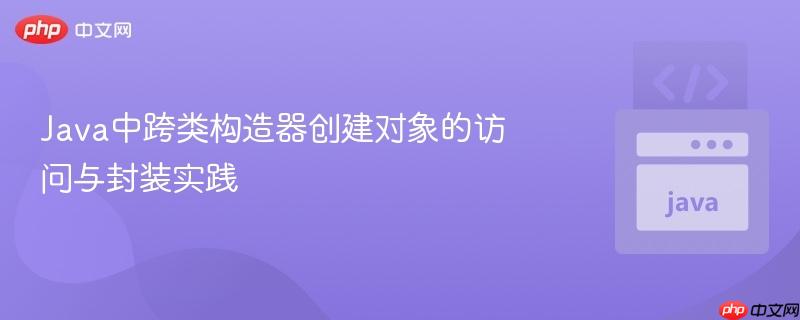
本文深入探讨了在java中从一个类的构造器内部创建的局部对象,如何在主类中进行有效访问的问题。通过分析局部变量作用域的限制,文章逐步演示了如何将局部变量提升为类成员变量,并通过实例进行访问。同时,强调了使用getter方法进行封装的必要性,以实现更好的代码结构和可维护性,并提供了详细的代码示例和最佳实践建议。
在Java编程中,理解变量的作用域是至关重要的。当在一个方法(包括构造器)内部声明一个变量时,该变量被称为局部变量,其生命周期和可访问性仅限于该方法内部。这意味着一旦方法执行完毕,局部变量就会超出作用域,无法从外部访问。
原始代码示例中,Bus 类的构造器内部创建了一个 Trip 对象:
public class Bus
{
// ... 其他成员变量
public Bus(int tripNumber)
{
this.tripNumber = tripNumber;
if (tripNumber==1)
{
// ... 初始化其他Bus属性
Trip trip1 = new Trip(this, tripNumber); // trip1 是一个局部变量
}
}
// ...
}这里,Trip trip1 变量被声明在 Bus 构造器内部的 if 语句块中,因此它是一个局部变量。这意味着,在 Interface(主类)中尝试通过 Trip.trip1.toString(); 或 bus1.trip1.toString(); 直接访问它时,编译器会报告“找不到符号”错误,因为它在构造器外部是不可见的。
要使在构造器中创建的对象能够在类的其他方法或外部被访问,需要将其声明为类的成员变量。这样,该对象将与类的实例绑定,并且在整个实例的生命周期内都可访问。
立即学习“Java免费学习笔记(深入)”;
首先,在 Bus 类中声明一个 Trip 类型的成员变量:
public class Bus
{
private int tripNumber;
private String model;
// ... 其他成员变量
private Trip trip1; // 将 trip1 声明为类的成员变量
public Bus(int tripNumber)
{
this.tripNumber = tripNumber;
if (tripNumber==1)
{
this.model = "Setra";
this.type = "2+2";
this.age = 8;
this.capacity = 40;
this.remainingCapacity = 23;
this.trip1 = new Trip(this, tripNumber); // 使用 this.trip1 赋值给成员变量
}
}
// ...
}通过将 trip1 声明为 Bus 类的成员变量,并在构造器中使用 this.trip1 进行赋值,trip1 现在成为了 Bus 实例的一部分。
一旦 trip1 成为 Bus 类的成员变量,就可以通过 Bus 类的实例来访问它。在 Interface(主类)中,创建 Bus 对象后,可以直接使用该 Bus 实例来访问其内部的 trip1 对象。
修改 Interface 类:
public class Interface
{
public static void main(String args[])
{
Bus bus1 = new Bus(1);
// 现在可以通过 bus1 实例访问其成员变量 trip1
if (bus1.trip1 != null) { // 检查 trip1 是否已被初始化
System.out.println(bus1.trip1.toString());
} else {
System.out.println("Trip object not initialized for this bus.");
}
}
}现在,bus1.trip1.toString() 可以成功调用,因为 trip1 是 bus1 实例的一个公共(或默认访问修饰符,此处为默认)成员。
尽管直接通过 bus1.trip1 访问成员变量可行,但在面向对象编程中,这通常不是最佳实践。直接访问成员变量违反了封装原则。更好的做法是提供一个公共的Getter方法来访问私有成员变量。这允许类内部控制如何暴露其内部状态,并为未来的修改提供了灵活性。
在 Bus 类中添加一个 getTrip() 方法:
public class Bus
{
private int tripNumber;
private String model;
// ... 其他成员变量
private Trip trip1; // 声明为私有成员变量
public Bus(int tripNumber)
{
this.tripNumber = tripNumber;
if (tripNumber==1)
{
this.model = "Setra";
this.type = "2+2";
this.age = 8;
this.capacity = 40;
this.remainingCapacity = 23;
this.trip1 = new Trip(this, tripNumber);
}
}
// 提供一个公共的Getter方法来访问 trip1
public Trip getTrip() {
return trip1;
}
public String toString()
{
return ("\n\tBus Information:\n\t\tBus: " + this.model + "\n\t\tType: " + this.type + "\n\t\tAge: " + this.age + "\n\t\tCapacity" + this.capacity + "\n\t\tRemainingCapacity" + this.remainingCapacity);
}
}修改 Interface 类以使用 getTrip() 方法:
public class Interface
{
public static void main(String args[])
{
Bus bus1 = new Bus(1);
// 通过 Getter 方法访问 Trip 对象
Trip currentTrip = bus1.getTrip();
if (currentTrip != null) {
System.out.println(currentTrip.toString());
} else {
System.out.println("Trip object not initialized for this bus.");
}
}
}这种方式不仅遵循了封装原则,还提高了代码的可读性和可维护性。
处理多个行程(Trip):如果一辆巴士可能有多趟行程,那么将 trip1 声明为单个 Trip 对象可能不够。在这种情况下,可以考虑使用 List
public class Bus {
private List<Trip> trips; // 使用列表存储多个行程
public Bus(...) {
this.trips = new ArrayList<>();
// ...
// 在构造器或方法中添加行程
if (tripNumber == 1) {
this.trips.add(new Trip(this, tripNumber));
}
}
public List<Trip> getTrips() {
return trips;
}
}然后,在主类中可以通过 bus1.getTrips().get(0).toString() 或遍历列表来访问行程。
构造器逻辑的健壮性:在 Bus 构造器中,trip1 只在 tripNumber==1 时被初始化。如果 tripNumber 不是1,trip1 将保持为 null。在访问 trip1 之前,务必进行 null 检查,以避免 NullPointerException。
依赖注入:对于更复杂的应用,当一个对象(如 Bus)需要依赖另一个对象(如 Trip)时,可以考虑使用依赖注入模式。这意味着 Trip 对象不是在 Bus 构造器内部创建的,而是作为参数传递给 Bus 构造器。这使得 Bus 类更加灵活和可测试。
public class Bus {
private Trip assignedTrip;
// Trip 对象作为参数传入
public Bus(int tripNumber, Trip trip) {
this.tripNumber = tripNumber;
this.assignedTrip = trip;
// ...
}
public Trip getAssignedTrip() {
return assignedTrip;
}
}
// 在主类中
public static void main(String[] args) {
Trip myTrip = new Trip(null, 1); // 先创建 Trip 对象
Bus bus1 = new Bus(1, myTrip); // 将 Trip 对象注入 Bus
System.out.println(bus1.getAssignedTrip().toString());
}(注意:这里的 Trip 构造器需要调整以接受 null 或一个实际的 Bus 实例,或者在创建 Trip 后再设置 assignedBus。)
在Java中,要从外部访问在类的构造器中创建的对象,核心在于理解变量的作用域。将局部变量提升为类的成员变量是解决此问题的关键一步。在此基础上,遵循面向对象设计原则,通过提供公共的Getter方法来访问私有成员变量,能够更好地实现封装,提高代码的健壮性、可读性和可维护性。对于更复杂的场景,应考虑使用集合来管理多个相关对象,并探索依赖注入等高级设计模式。
以上就是Java中跨类构造器创建对象的访问与封装实践的详细内容,更多请关注php中文网其它相关文章!

每个人都需要一台速度更快、更稳定的 PC。随着时间的推移,垃圾文件、旧注册表数据和不必要的后台进程会占用资源并降低性能。幸运的是,许多工具可以让 Windows 保持平稳运行。

Copyright 2014-2025 https://www.php.cn/ All Rights Reserved | php.cn | 湘ICP备2023035733号